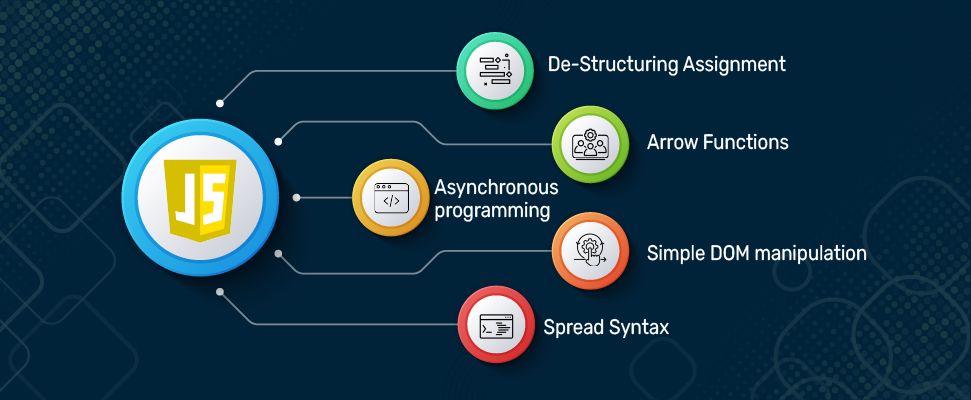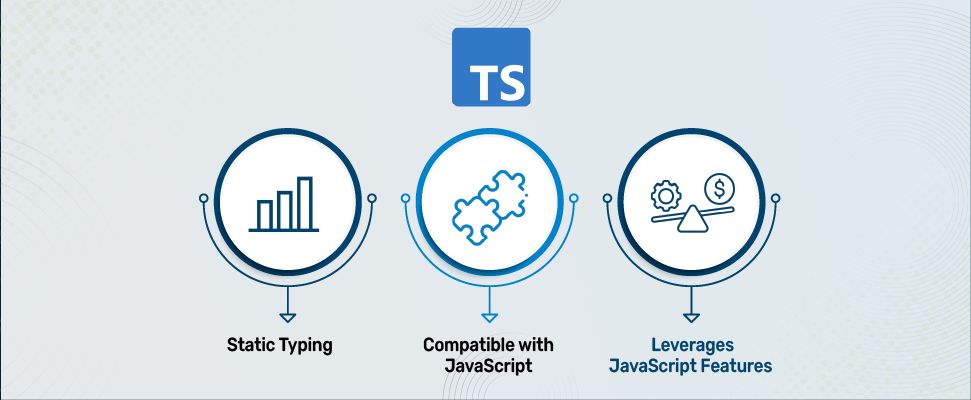Table of Contents
ToggleIntroduction
JavaScript and TypeScript are the two programming languages that have emerged as compelling choices for web development. JavaScript is a scripting language that adds dynamic behavior to a webpage. Whereas Typescript is built on top of JavaScript and offers advanced features like live bug checking and static typing. This blog sheds light on the key differences between TypeScript and JavaScript.
What is JavaScript?
JavaScript is primarily used for client-side web development, developed by Brendan Eich in 1995 as a cross-platform, high-level, interpreted programming language. It is used along with HTML and CSS to make the front end more interactive and dynamic, with many functionalities. It integrates well with the XML and REST APIs. Modern web browsers run JavaScript to create dynamic content with multimedia and animated images. Besides, it is also commonly used to build web games to make websites more interactive and boost the user experience.
Features of JavaScript
The following features of JavaScript make web development easier: Let’s have a look at it:

- Asynchronous programming: Today, everything from ordering food to booking a flight is possible using APIs. It enables different software applications to communicate with each other, and in this API-driven world, asynchronous programming features ensure your app’s responsiveness. It also promotes cleaner code, avoids callback hell, handles timeouts, and deals with multiple asynchronous operations with ease.
- De-Structuring Assignment: This feature is beneficial for developers to extract values from objects and arrays. Not only that, they can work with complex data structures with ease and, at the same time, eliminate repetitive array index referencing. Moreover, it improves the code readability and minimizes the number of lines required for variable assignments.
- Arrow Functions: Developers can write concise code using functions in a more compact and expressive way. Apart from that, it also provides lexical scoping, which allows them to capture the value of “this” from the surrounding context and avoid potential scope-related bugs.
- Simple DOM manipulation: The Document Object Model (DOM) allows JavaScript to interact with XML and HTML files. It is like a bridge between JavaScript and the content of a webpage. With this simple DOM manipulation, JavaScript can add dynamic and more interactive functions to web pages.
- Spread syntax: This feature is included in ES6, which allows developers to spread any elements of an object or array. Also, developers can concatenate and merge arrays and objects and use them as per their convenience. Overall, it simplifies the common tasks, like passing multiple arguments to functions or creating copies of existing data structures.
Must read: Is JavaScript Worth Learning?
What is TypeScript?
Developed by Microsoft, TypeScript is a statically compiled, object-oriented programming language. It is used for developing both client-side and back-end applications. It is an improved version of JavaScript that works in any browser with ECMAScript 3 support. Besides, it can also execute on Node.js and supports types, classes, and interfaces. The online TypeScript compiler is free and can be used with any text editor.

Don't miss out on your chance to work with the best
Apply for top global job opportunities today!
Why was TypeScript Developed When We Had JavaScript?
JavaScript was primarily released to build interactivity and increase engagement on the web pages. Eventually, developers realized that with the object-oriented features, it could be used for back-end development too. With the release of Node.js, JavaScript can be used to build the backend of web apps. But its code was heavy and complex, due to which it could not be as beneficial as they assumed. Although it could be used in server-side development, it still has some limitations. To overcome these challenges in JavaScript, TypeScript was developed and introduced by Microsoft. Typescript has the nature and characteristics of JavaScript but with better and more advanced support. TypeScript is suitable for the frontend and backend of web app development. It can work well with complex and large-scale enterprise projects.
TypeScript Features

- Static Typing: Developers need to declare variable types before writing a program. This, as a result, allows them to detect early bugs, better IDE support, smooth manufacturing, and improved code.
- Compatible with JavaScript: TypeScript is the perfect mix of old and new features of JavaScript. This makes it more compatible with every version of JavaScript, even ES7 and ES12. This ensures a smooth transition and the portability of the language.
- Leverages JavaScript Features: Since TypeScript is a superset of JavaScript, its advanced features consist of additional features of JavaScript. Due to this, developers can effectively use the JavaScript framework while working on client-side development.
TypeScript vs. JavaScript: Key Differences
| Factors | TypeScript | JavaScript |
|---|---|---|
| Ease of Learning | complex learning structure | easy to learn |
| Code maintenance | Static nature and typographical conventions promote easier code maintenance | The dynamic nature makes it challenging to maintain the code |
| Readability | Support of interfaces promotes clear and concise code | Less readable than TypeScript |
| File Extension | TypeScript files from JavaScript files with .ts extension | It uses a .js extension. |
| Typing | Strongly typed | Loosely typed |
| Complexity | Static features increase the complexity | Comparatively less complex than TypeScript. |
| Tools and Frameworks | Offers Nest.js, Feather.js, loopback.js, Adonis.js, and Ts.Ed | Offers Vue, Angular, Express, andNext.js |
| Syntax | Allows variable declaration, functional paradigm, and type system | follows the ECMAScript definition and uses many structured programming terminologies |
| IDE Support | Visual Studio Code, web storm, and Vim | Atom, IntelliJ, Eclipse, Komodo,an Brackets |
| Debugging | It compiles the code and the developer needs to declare the variable | It interprets the code line by line, which makes it difficult to detect errors |
| Prototype | Support the feature | Doesn’t support this feature |
| Community | It has a small and supportive community | It has a large and supportive community |
| Data binding | It uses classes and objects thus; data binding is possible | It uses the first-class functions therefore data binding is not possible. |
What Are the Benefits of Using TypeScript Over JavaScript?
- Static Nature: TypeScript’s static nature helps developers identify bugs early; this early detection of errors promotes code quality and maintainability.
- Great Tooling Support: TypeScript enables developers to navigate code, and use intelligent code completion, and refactoring tools. Altogether, this offers superior tooling support and boosts developer productivity by twice as much.
- Object-Oriented Features: Although JavaScript also supports object-oriented features, it still cannot leverage some of the features effectively. However, with TypScript, object-oriented programming concepts facilitate the development of scalable and maintainable codebases.
- ES6/ES7 Features Support: TypeScript supports the latest ECMAScript features, allowing developers to leverage modern JavaScript syntax and features. On top of that, TypeScript is compatible with JavaScript.
Related post: Angular: JavaScript Web App Framework
Challenges Faced Using TypeScript Over JavaScript
- Steeper Curve: Developers who are not familiar with the concept of static typing will have difficulty grasping the concept easily. This will increase the learning curve and the development time.
- Compilation Step: Since TypeScript needs to convert its code to JavaScript, this adds overhead and increases complexity.
- Extra Work in Smaller Projects: TypeScript is not beneficial for smaller projects as it needs additional steps like compilation and annotations. Due to this, it includes more additional work and makes simple projects complex.
Can TypeScript Replace JavaScript in the Future?
Not at all! TypeScript is a subset of JavaScript and inherited many characteristics from JavaScript. But it is a completely different language; thus, there is no chance in the future that it will replace JavaScript. In web development, JavaScript has a pivotal role and is one of the building blocks.
Unlike JavaScript, TypeScript doesn’t execute directly in browsers. every time its code needs to be compiled into JavaScript. Therefore, it relies on JavaScript for code execution and debugging. Also, TypeScript is not a perfect fit for all projects. This leads to the conclusion that both programming languages have strengths and weaknesses. To stay up to date with web development trends, businesses, and web developers need to adopt a new technology or framework to deliver better business and keep up with client requirements. If you’re a web developer and looking for roles in an esteemed organization, then sign up with Olibr and never miss the opportunity.
Take control of your career and land your dream job
Sign up with us now and start applying for the best opportunities!

Frequently Asked Questions
A TypeScript interface is a way to define the structure of an object. It specifies the properties and methods that an object should have without providing any implementation details. Interfaces help enforce a contract between different parts of the codebase, ensuring consistency and type safety.
You can create a TypeScript interface using the interface keyword followed by the interface name along with the list of properties or methods.
Some of the benefits of TypeScript interfaces are code reusability, maintainability, better code organization, and smooth communication between developers.
You can use the JavaScript setTimeout function to set a delay time. Users can add arguments to pass to the function. After the specified delay, the function will be executed asynchronously.
Examples of JavaScript compilers are Babel and the Google Closure Compiler.
Hoisting in JavaScript allows variable and function declarations to be accessible throughout the entire scope.

